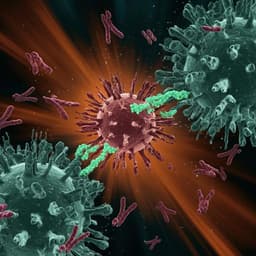
Medicine and Health
An mRNA-based T-cell-inducing antigen strengthens COVID-19 vaccine against SARS-CoV-2 variants
W. Tai, S. Feng, et al.
This innovative study by Wanbo Tai and colleagues introduces a groundbreaking mRNA-based vaccine that effectively targets conserved regions of the SARS-CoV-2 virus. By focusing on T-cell responses and combining it with existing RBD-based vaccines, this research shows promising results against emerging variants, underscoring the importance of robust immune response for effective COVID-19 vaccination.
~3 min • Beginner • English
Introduction
SARS-CoV-2 variants frequently accumulate mutations in Spike, especially within the receptor-binding domain (RBD), enabling escape from vaccine- or infection-induced neutralizing antibodies and leading to breakthrough infections. Because epitopes recognized by T cells are distributed across the SARS-CoV-2 proteome and are generally more conserved, robust CD8+ and CD4+ T-cell responses are thought to contribute to protection, even when neutralizing antibodies are diminished. The study aims to design and test an mRNA-based antigen that preferentially induces broad CD8+ T-cell responses by encoding regions enriched in human HLA class I epitopes, and to evaluate whether combining such a T-cell-inducing antigen with an RBD-based antigen improves protection against SARS-CoV-2 variants, including Beta and Omicron BA.1.
Literature Review
The authors reference prior evidence that: (1) neutralizing antibody responses to Spike, particularly RBD, are reduced against variants such as Beta and Omicron; (2) T-cell immunity, especially CD8+ responses, correlates with better COVID-19 outcomes and can control coronaviruses even in the absence of antibodies; (3) SARS-CoV-2-reactive T-cell epitopes are widely distributed across structural and nonstructural proteins, with many conserved across variants; (4) previous vaccines and infections largely preserve T-cell reactivity to variants, including Omicron, though some reductions occur in subsets of individuals; and (5) mRNA vaccine platforms efficiently elicit cellular responses due to endogenous antigen expression and MHC presentation. These data support vaccine designs that augment cellular immunity, targeting conserved nonspike regions to improve breadth and durability.
Methodology
- In silico epitope prediction: Predicted HLA-I epitopes across the SARS-CoV-2 proteome (Wuhan-Hu-1) for 78 common HLA-I alleles using NetMHCpan 4.1 and IEDB. Effective epitopes were those with IC50 < 10 nM. Identified epitope-enriched fragments (>20 effective epitopes per 100 aa): NSP3 1443-1605, NSP4 232-444, NSP6 1-201, and M 1-113. Selected three negative-control regions with few epitopes (NSP1 1-180, NSP3 1066-1278, NSP14 330-490). Included N full-length for testing.
- Ex vivo validation with convalescent T cells: Generated HEK293T reporter cells stably expressing HLA-A*02:01 or HLA-A*11:01, granzyme B-responsive infrared fluorescent protein reporters, and transiently expressing candidate fragments. Co-cultured with HLA-matched memory CD8+ T cells from convalescent donors; measured activation via reporter fluorescence.
- mRNA vaccine constructs: Synthesized nucleoside-modified mRNAs (1-methylpseudouridine) with Cap1 and poly(A). HLA-EPs construct encoded tandem NSP3 1443-1605, NSP4 232-444, NSP6 1-201 separated by A-A-Y linkers, N-terminal ubiquitin (G76A) for proteasomal targeting, C-terminal V5 tag. Negative-control HLA-NC used three low-epitope fragments similarly formatted. RBDbeta mRNA encoded signal peptide and RBD containing K417N, E484K, N501Y (B.1.351), with a Flag tag. mRNAs were formulated into lipid nanoparticles (LNP-HLA-EPs, LNP-NC, LNP-RBDbeta); characterized size and distribution; luciferase mRNA-LNP used to assess in vivo biodistribution in BALB/c mice.
- In vitro expression and processing: Transfected HEK293T cells; assessed HLA-EPs degradation with/without proteasome inhibitor MG132 by flow cytometry; confirmed RBDbeta expression by Western blot and flow cytometry.
- Mouse immunizations: Humanized HLA-transgenic C57BL/6J strains HLA-A*02:01/DR1 and HLA-A*11:01/DR1. Regimen A: LNP-HLA-EPs at 0.5 µg or 10 µg/dose i.m., prime-boost 3 weeks apart; LNP-NC (10 µg) control. Regimen B: HLA-A*02:01/DR1 mice received LNP-RBDbeta (0.5 µg) alone, LNP-RBDbeta + LNP-HLA-EPs (0.5 µg each), or PBS buffer, prime-boost. Assessed GC B and Tfh cells in lymph nodes, serum RBD-specific IgG (ELISA), live virus neutralization, cellular responses (ELISpot IFN-γ/IL-4; intracellular cytokine staining for IFN-γ, TNF-α), memory T-cell phenotypes. HLA tetramer staining evaluated epitope recognition for variant substitutions.
- CD8+ T-cell depletion: In vaccinated mice, anti-CD8α mAb administered on days -1 and 0 relative to challenge; depletion verified by flow cytometry.
- Mouse challenges: Intranasal challenge at 21 days post-boost with SARS-CoV-2 Beta (B.1.351; 1.4×10^5 PFU) or Omicron BA.1 (B.1.1.529; 2.0×10^5 PFU). Assessed viral loads in lungs and tracheae by plaque assay and qRT-PCR at 4 dpi; histopathology by H&E.
- Nonhuman primate study: Female rhesus macaques (n=3/group) immunized i.m. with LNP-RBDbeta (100 µg), LNP-RBDbeta + LNP-HLA-EPs (100 µg each), or PBS on days 0 and 21. Measured RBDbeta-specific IgG (ELISA) over time; neutralization of pseudoviruses and live variants (WT, Alpha, Beta, Gamma, Delta, Omicron BA.1). Cellular responses assessed by PBMC ELISpot (IFN-γ, IL-4) and cytokine ELISAs. Challenge on day 42 with 7.0×10^5 PFU Beta via intranasal/intratracheal routes. Monitored sgRNA in throat/anal swabs (days 0,1,3,5,7) and lung lobes at 7 dpi by qRT-PCR; lung histopathology.
- Statistics: One- or two-way ANOVA with appropriate multiple-comparison corrections; limits of detection and quantification specified per assay.
Key Findings
- Identified three highly immunogenic HLA-I epitope-enriched regions in nonstructural proteins (NSP3 1443-1605, NSP4 232-444, NSP6 1-201) that activated CD8+ T cells from convalescent donors more robustly than M 1-113 or N full-length in reporter assays.
- LNP-HLA-EPs immunization in HLA-A*02:01/DR1 and HLA-A*11:01/DR1 mice increased CD8+ T-cell frequencies, generated effector and central memory CD8+ T cells, and elicited strong IFN-γ responses in a dose-dependent manner (0.5 vs 10 µg).
- Protection in mice: Following Beta variant challenge (1.4×10^5 PFU, 4 dpi), LNP-HLA-EPs significantly reduced lung viral loads (plaque assay and qRT-PCR) and lung pathology in both HLA-transgenic strains; protection was abrogated by CD8+ T-cell depletion, indicating CD8 dependence.
- Epitope conservation: Most variant substitutions in NSP4 232-444 and NSP6 1-201 did not overlap predicted effective epitopes; HLA tetramer staining showed no significant difference between wild-type and mutated epitopes, supporting preserved immunogenicity across VOCs.
- Dual immunization in mice (0.5 µg each of LNP-RBDbeta + LNP-HLA-EPs) increased GC B and Tfh cells and produced RBD-binding antibodies across variants; neutralizing titers were reduced against Omicron BA.1 relative to other strains. Dual vaccination elicited strong Th1-biased cellular responses (IFN-γ, TNF-α) in both CD8+ and CD4+ T cells.
- Protection against variants in mice: Against Beta, dual immunization reduced lung and tracheal viral titers and pathology more than RBDbeta alone. Against Omicron BA.1, RBDbeta alone failed to protect (higher viral loads), whereas dual immunization rendered infectious virus largely undetectable and prevented lung pathology. CD8 depletion eliminated this protection.
- Nonhuman primates: Dual immunization (100 µg each) induced robust RBDbeta-specific IgG and broad neutralization against multiple variants, with lower titers to Omicron BA.1. Th1-skewed cellular responses were higher in dual-vaccinated macaques (increased IFN-γ spots; IL-4 unchanged). After Beta challenge (7.0×10^5 PFU), dual vaccination markedly reduced sgRNA in throat/anal swabs (becoming undetectable by day 3–5) and prevented viral detection in most lung lobes with minimal histopathology, outperforming RBDbeta alone.
- Overall, combining a conserved, T-cell-focused antigen (HLA-EPs) with an antibody-inducing RBD antigen improved protection against VOCs, particularly Omicron BA.1, relative to RBD alone.
Discussion
The study addresses the challenge of immune escape by SARS-CoV-2 variants from RBD-focused humoral responses by incorporating a T-cell-inducing antigen that targets conserved nonstructural regions enriched for human HLA-I epitopes. The HLA-EPs mRNA, designed with a ubiquitin tag to enhance proteasomal processing and MHC-I presentation, generated strong, CD8-dependent cellular immunity and memory. Because the selected NSP regions are conserved across VOCs, the induced T-cell responses remained effective despite variant mutations. When combined with an RBDbeta mRNA that elicits neutralizing antibodies, the dual vaccine regimen produced complementary humoral and cellular immunity, resulting in superior control of Beta and especially Omicron BA.1 infections in HLA-transgenic mice and rhesus macaques. The findings support vaccine designs that include conserved nonspike antigens to broaden protection, mitigate the impact of antigenic drift in Spike, and sustain efficacy against current and emerging variants.
Conclusion
The authors developed an LNP-formulated mRNA vaccine encoding three conserved, HLA-I epitope-enriched NSP fragments (HLA-EPs) that robustly prime CD8+ T-cell responses and confer CD8-dependent protection in humanized HLA-transgenic mice. Combining HLA-EPs with an RBDbeta mRNA antigen enhanced protective efficacy against SARS-CoV-2 Beta and Omicron BA.1 in both mice and nonhuman primates compared with RBDbeta alone, highlighting the value of co-inducing humoral and cellular immunity. The work suggests that optimal next-generation COVID-19 vaccines should incorporate conserved nonspike T-cell targets alongside neutralizing antibody-inducing antigens (e.g., full-length Spike or RBD). Future research could evaluate HLA-EPs combined with full-length Spike, expand HLA coverage, assess durability, dose optimization, and advance to human clinical trials.
Limitations
- Translational scope: Efficacy was demonstrated in HLA-transgenic mice and a small cohort of rhesus macaques (n=3 per group), not in humans; generalizability requires clinical evaluation.
- HLA coverage: Although epitopes were predicted for 78 common HLA-I alleles, in vivo testing focused on HLA-A*02:01/DR1 and HLA-A*11:01/DR1 mice; responses in other HLA contexts remain to be validated.
- Antigen selection: The RBDbeta construct was used rather than full-length Spike; breadth of humoral responses and optimization of antigen combinations may differ with other Spike formats.
- Time frame and endpoints: Protection and immune readouts were measured at early time points post-boost (e.g., 21 days) and 4–7 days post-challenge; durability and long-term memory were not assessed.
- Variant scope: Protection was tested against Beta and Omicron BA.1; efficacy against later Omicron sublineages or other emerging variants was inferred from conservation analyses but not directly tested.
Related Publications
Explore these studies to deepen your understanding of the subject.







